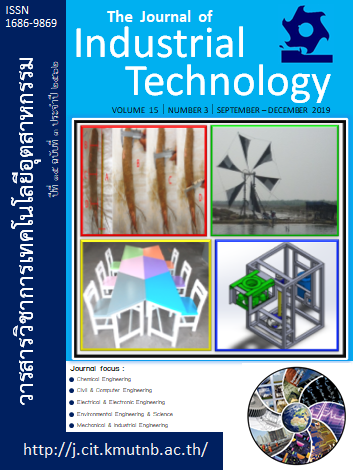(ผลกระทบของความหนาและอัตราภาระต่อความต้านทานการแตกหักภายใต้ภาระรูปแบบที่ 1ของอีพอกซีเรซิน)
คำสำคัญ:
อีพอกซีเรซิน, การแตกหักภายใต้ภาระรูปแบบที่ 1, ความหนา, อัตราภาระบทคัดย่อ
บทคัดย่อ
ปัจจุบันวัสดุกลุ่มพอลิเมอร์ได้เริ่มเข้ามามีบทบาทในชีวิตของมนุษย์มากขึ้น โดยอีพอกซีเรซินเองก็เป็นหนึ่งในวัสดุกลุ่มพอลิเมอร์ที่นิยมใช้งานกันอย่างแพร่หลายเนื่องจากคุณสมบัติทางกลที่ค่อนข้างสูงและสามารถขึ้นรูปได้ง่ายเนื่องจากมีสถานะเป็นของเหลวก่อนการขึ้นรูป การที่อีพอกซีเรซินง่ายต่อการขึ้นรูปนี้ทำให้อีพอกซีเรซินถูกนำไปใช้งานในอุตสาหกรรมหลายภาคส่วน ลักษณะการใช้งานที่หลากหลายส่งผลให้ลักษณะการรับภาระหรือขนาดของชิ้นส่วนที่ทำจากอีพอกซีเรซินแตกต่างกันไปด้วย ในการใช้งานชิ้นส่วนที่ทำจากอีพอกซีเรซินหรือมีอีพอกซีเรซินเป็นส่วนประกอบจะพบว่าหลายครั้งชิ้นส่วนเกิดการเสียหายภายใต้ภาระที่ต่ำกว่าที่ออกแบบไว้ เนื่องจากการออกแบบชิ้นส่วนที่ซับซ้อนเหล่านั้นไม่ได้คำนึงถึงการเกิดรอยร้าวบนชิ้นส่วนนั่นเอง กรณีที่ชิ้นส่วนมีความซับซ้อนปัจจัยที่สำคัญที่ต้องคำนึงถึงคือความต้านทานการแตกหักของวัสดุที่ใช้ทำชิ้นส่วน ดังนั้นในงานวิจัยชิ้นนี้จึงมุ่งศึกษาถึงความต้านทานการแตกหักของอีพอกซีเรซินภายใต้ภาระรูปแบบที่ 1ซึ่งจำลองลักษณะการใช้งานที่หลากหลายด้วยการเปลี่ยนแปลงช่วงของตัวแปรอัตราภาระและความหนาของชิ้นทดสอบ สำหรับการคำนวณความต้านทานการแตกหักนั้นจะใช้การคำนวณด้วยวิธีไฟไนต์เอลิเมนต์ จากการทดสอบจะพบว่าอัตราภาระและความหนาของชิ้นทดสอบต่างส่งผลกระทบที่ชัดเจนต่อความต้านทานการแตกหักและพฤติกรรมการแตกหักของอีพอกซีเรซิน
เอกสารอ้างอิง
[1] Y. Torres, V.K. Sarin, M. Anglada. L. Llanes, “Loading Mode Effects on the Fracture Toughness and Fatigue Crack Growth Resistance of WC-Co Cemented Carbides”, Scipta Materialia 52, 2005, pp.1087-1091.
[2] Yi-Lan Kang, Zhi-Feng Zhang, Huai-Wen Wang, Qing-Hua Qin, “Experimental Investigation of the Effect Thickness on Fracture Toughness of Metallic Foils”, Materials Science and Engineering: A 394, 2005, pp.312-319.
[3] Yanyun Zhao, Mengtian Liang, Zhenyu Zhang, Man Jiang, Shaojun Liu, “Fracture Toughness and Fracture Behavior of CLAM Steel in the Temperature Range of 450°C-550°C”, Journal of Nuclear Materials 501, 2018, pp.200-207.
[4] M. B. Roller, “Characterization of the Time-Temperature-Viscosity Behavior of Curing B-Staged Epoxy Resin”, Plastic Engineering 15, 1975, pp.406-414.
[5] N.J. Mills, “Plastics: Microstructure and Engineering (2nd ed.)”, Amold, London, 1993.
[6] Ph. Beguelin, H. H. Kausch, “The Effect of the Loading Rate on the Fracture Toughness of Poly (methyl methacrylate), Polyacetal, Polyetheretherketone and Modified PVC”, Journal of Materials Science 29, 1994, pp.91-98.
[7] C. Kanchanomai, S. Rattananon., “Effect of Loading Rate and Thickness of Thermoset Epoxy Resin”, Journal of Applied Polymer Science 109, 2008, pp.2408-2416.
[8] J. Jamali, Y. Fan, J. T. Wood., “The Mixed-Mode Fracture Behavior of Epoxy by the Compact Tension Shear Test”, International Journal of Adhesion & Adhesives 63, 2015, pp.79-86.
[9] ASTM D638, “Standard Test Method for Tensile Properties of Plastics”, West Conshocken, PA: ASTM; 2014.
[10] M.R. Ayatollahi, B. Saboori, “A New Fixture for Fracture Tests Under Mixed Mode I/III Loading”, European Journal of Mechanics A/Solids 51, 2014, pp. 67-76.
[11] ASTM D5045, “Standard Test Methods for Plane-Strain Fracture Toughness and Strain Energy Release Rate of Plastic Materials”, West Conshocken, PA: ASTM, 2014.
[12] T. L. Anderson, “Fracture Mechanics Fundamentals and Applications Book (2nd ed.)”, 1994.
[13] Mechanical Engineering, Suranaree University of Technology, “Tensile Testing”, Available: http://eng.sut.ac.th/me/2014/laboratory/document/Tensile_Test.pdf. (in Thai)
[14] Asst. Prof. Jirapong Kasivitamnuay, “Fracture”, Available:http://pioneer.netserv.chula.ac.th/~kjirapon/Fracture%20book.pdf. (in Thai)
[15] F. Ren, J. J. Wang, W. D. Bertelsen, “Fractographic Study of Epoxy Under Mode I and Mixed Mode I/III Loading”, Materials Science and Engineering A 532, 2011, pp.449-455.


